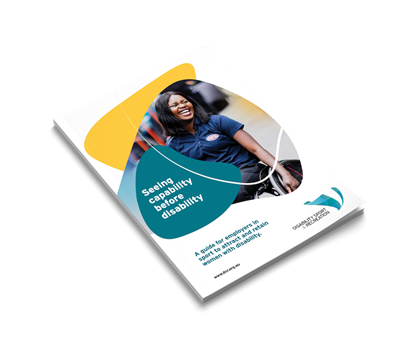December 2020

Inclusion in the workplace is vital, yet women who have a disability are significantly underrepresented, particularly in the sport sector.
To open employment pathways and provide access to women with disability who want to work in the sport and recreation industry, the Victorian Government and Disability Sport and Recreation were keen to understand what strategies would assist organisations employ more women who have a disability. Together with the expertise of the Institute of Health and Sport at Victoria University, insights were gained from women with disability who currently worked in the sector, for example, in program development, administration, or who were in voluntary leadership roles in sport such as the club secretary or in coaching.
Brief summary of findings
Benefits of employing women with disability
These women believed managers were not aware of the benefits of employing women with disability, for example, they were not aware of the resilience, determination and passion to succeed in their roles, or of employee stability or the benefits of diverse people skills and knowledge or skills and experience of disability. Or the skill set and experience they bring to the work place and the benefits they inherently bring in helping employers display their commitment and focus to employee diversity and inclusiveness.
“I think people with a disability have a drive about them, you spend a lot of your time trying to fit into society and being a female in a work environment… If you employ a female with a disability they are going to be quite driven”.
Barriers that exist
Key barriers were recognised that prevented working in sport and recreation organisations including:
- Negative assumptions and discrimination in organisational culture and employee perceptions and attitudes
- Lack of opportunity in organisational roles and in career progression to leadership positions
- Unwelcoming environment caused by social and physical environmental barriers
- Lack of understanding and support from managers and employees on proactive adjustments required
- Lack of understanding from managers on access to resources available from the government to assist in the provision of required adjustments. These women, during interviews, referred to assistance that could be gained which panel members were not aware of including “a vision impaired women might need special equipment like a screen reader equipment or special computers, CCTV that can all be financed by the government”.
Good practice strategies that exist
A range of good workplace practice strategies were recognised that assisted with attraction, development and retention of women with disability including:
- The language and content provided in the job description, for example, ‘applicants who have a disability are encouraged to apply’
- During interviews the panel asks questions about needs and accessibility requirements including ‘What do you need us to do to make this role easier for you?’
- Disclosure of disability was enabled in an open and comfortable environment, the most common time was during interviews where women felt they could open the conversation, explain it from their perspective, and focus on their skill set rather than the disability
- Organisational support, particularly at the induction stages and entering into and succeeding in leadership positions
- Welcoming environments created by employees, for example, prior to the first day conduct an orientation introducing all colleagues, and clearly identify role and responsibilities
- Accessibility including the provision of options to access documents, nearby parking for an associated disability, and disability friendly policies and practices such as a fire escape plan
- Recognising the woman based on her attributes and how she contributes to advancing the organisation
- Immediate implementation of support systems including workplace adjustments, this also included disability friendly policies and practices
- Disability inclusive employee training and a support manual
- Flexibility in the workplace such as the ability to take breaks when required, tailored leadership roles, and flexible work hours
- Acknowledging the strengths of the woman
- Raising the profile of women with disability who are leaders in an organisation
- ‘Champions’, mentors and networks were vital to assist with self-confidence, career success, creating relationships, guidance, learning from personal experiences, developing support networks and becoming a leader

The Guide
Findings were translated into strategies and an interactive Guide developed and piloted in the sport community. There's a good practice case study and existing and new resources to assist sport organisations. People are encouraged to download the guide on the Disability Sport and Recreation site: https://dsr.org.au/seeing-capability-before-disabilit
Queries related to the Guide can be forwarded to Ayden Shaw, Manager Sport and Recreation, Disability Sport & Recreation [email protected]
Professor Clare Hanlon, Institute of Health and Sport, Victoria University


